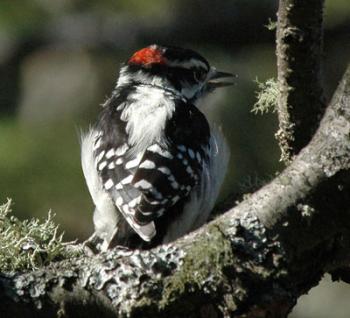Making Woodland Music

Downy woodpecker
Photo credit: Jim Williams
by Val Cunningham
Contributing Writer
Downy woodpeckers can be heard near and far as they smack their beaks on resonant surfaces to warn or invite.
Backyard woodpeckers are the percussionists of the natural world, pounding out rapid staccatos with their beaks to make music. As a matter of fact, humans and woodpeckers (and a few insects) are the only true instrumentalists in the animal kingdom—the sounds made by most insects and other birds are produced with their bodies.
Woodpecker drumming—brief, loud series of knocks that carry over long distances—convey the same territorial or courtship messages as singing does for songbirds. Woodpeckers make their music on resonant surfaces, especially on early spring mornings. The “drumhead” might be a tree, power pole, fencepost, or a house’s siding or metalwork (not appreciated by sleeping humans).
Our most common backyard woodpecker, the sturdy little downy, is also the smallest, not much larger than a house sparrow. Like all woodpeckers, downies are superbly adapted to a life in the trees. They nest in trees, sleep in trees and search for food inside trees and hidden in bark. They’re likely to be found in forests and woodlots, but they’re also frequent flyers to bird feeders, especially those that offer suet, black oil sunflower seeds or shelled peanuts.
Take a walk in the woods in fall or winter and you’re likely to encounter a mixed flock of small birds searching for food together. Such a foraging flock could include chickadees, nuthatches, kinglets, brown creepers and a downy woodpecker, occasionally giving his species’s characteristic “pik, pik” call or the daffy “whinny” sound. They’re an easy-going bird, not likely to flush from its perch until an intruder is within a few feet.
Males sport a brilliant red patch at the back of their heads, making them easy to distinguish from plainer females. Their high-contrast black and white feathers fade into the tree bark when predators like Cooper’s hawks are around.
Downy woodpeckers are industrious, busily traveling up tree trunks and over branches, probing bark for hidden insects or their egg sacs. Their very short beaks dictate a “peer and poke” foraging style. They’ll pause, peer more closely, peck at the bark, and then move on upward. Even in winter, much of a downy’s diet is made up of insect matter, and they can be a significant force in keeping wood-boring insects at bay.
Downies also consume acorns and beechnuts, corn, sunflower seeds and berries, and they lick sap when it’s running. Some savvy birds have taught themselves to cling to hummingbird feeders to lap up the nectar inside. Another favorite treat is the fly larvae inside the round galls on goldenrod stems.
Kids always ask why downies don’t develop fierce headaches from all that pecking and pounding on hard surfaces. The answer is that head and neck bones and muscles act as shock absorbers. Just before winter, they’re busy excavating holes in dead limbs or tree snags to serve as nighttime shelters. Downies may carve out more than one night roost, since larger woodpeckers and squirrels sometimes evict them.
Our backyard feeders may not make the difference between life and death for a downy, but the supplemental calories they provide do keep the woodpeckers in better shape to survive the winter. This is especially true for females, who are driven from the best natural feeding spots by males.
After a long winter, both males and females are eager to find a good, loud instrument to announce to the world that they’re back in the music business.
Holey houses
A woodpecker drumming on a house generally doesn’t create holes, but the downy’s larger cousins, the hairy and pileated woodpeckers, can cause a great deal of damage to wooden structures as they search for food or make nest holes. For tips on discouraging these determined birds, visit a handy Cornell Lab of Ornithology site.
St. Paul MN resident Val Cunningham, leads bird hikes for the St. Paul Audubon Society and writes about nature for local, regional and national newspapers and magazines.



